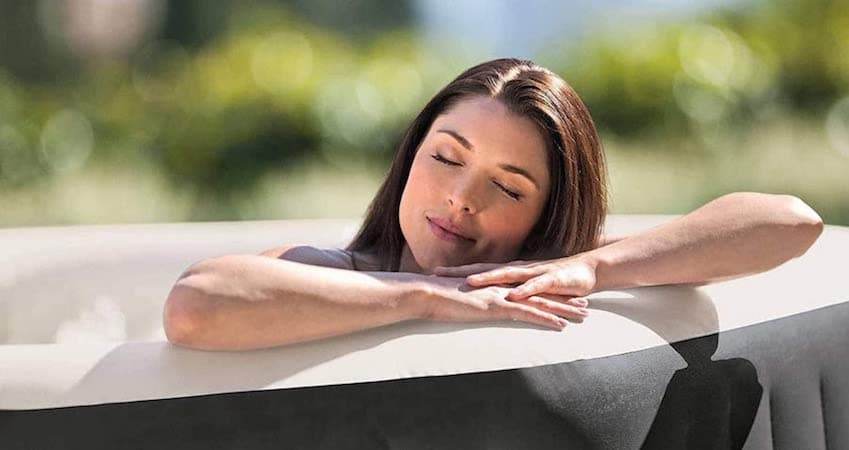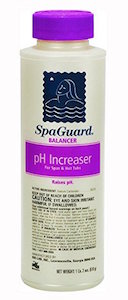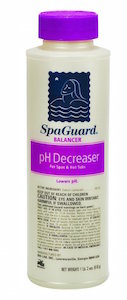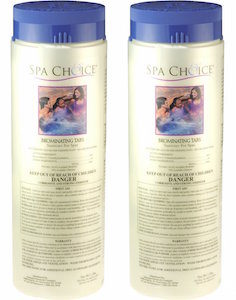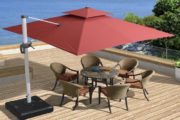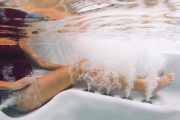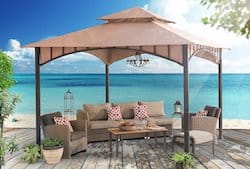This independent website is funded by its readers. It can earn a commission on any purchases made through product links, at no extra cost to the buyer. Learn more >
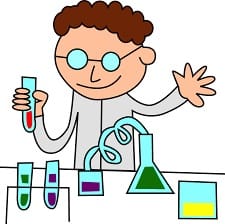
Do your eyes glaze over when you come across words like alkaline, total alkalinity, hard water, PPM, PH and test strips?
Yikes !!
Are you the kind of person who thinks that “free chlorine” means your local pool shop has turned into a charitable organisation?
Hey, better get down there fast, that free stuff always runs out quickly !!
Don’t worry you are not alone. And don’t worry, your hot tub chemical treatment is going to be a breeze.
The ratio of spa water to hot tubbers is going to be high. A typical inflatable hot tub holds just 250 to 300 gallons of water and sometimes 4-6 people.
This combined with the normal tub operating temperature of 104º fahrenheit produces a potential breeding ground for unpleasant germs, fungi and bacteria. No offence intended to the hot tubbers !!
But obviously we don’t want to open our tub one day to find a cloudy, smelly mess.
Don’t panic, these days you don’t need a university degree in chemistry to manage hot tub hygiene effectively. Your hot tub chemical treatment is going to be easy.
Hot tub ownership is great, but along with it comes the responsibility of keeping the users safe.
So lets see how….
HOT TUB CHEMICAL TREATMENT
A hot tub and a swimming pool both have water that we enjoy splashing around in. But that’s where the similarity ends.
Let’s not confuse the two when we are thinking about chemical treatment. A spa is not a mini swimming pool.
It cannot be left on its own. It needs constant checking, especially if it is being heavily used.
LET’S GET TESTING
So we’re going to need some kind of way to test our water. We need an easy way to look at levels of chlorine / bromine, pH, and total alkalinity. And ideally we want just one kit that is going to test all these main water characteristics at once.
Again don’t worry lots of help is at hand, in fact maybe too much!!
There’s so many products available to do this it’s kinda hard to choose which one to go for. You can find digital testers, hand held water chemical meters, or go old school.
We prefer old school, from an old school company, that’s why we recommend the Taylor K-1003 Pool and Spa Water 4-In-1 Test Kit.

on Amazon.com
Yikes!!!
It may look like a chemistry set, but it isn’t. It’s easy to understand, easy to use, and comes from a US company with clear instructions in simple English. It has everything we are going to need all in one small box.
But if you are a gadget person then of course there is always digital help to check the chemical levels in your hot tub water.
on Amazon.com
FIRST STEP: TOTAL ALKALINITY
Verifying and adjusting total alkalinity is the first easy step in our water hygiene check.
We are looking for a number of 80 – 110 ppm. It’s important to get this value about right because it helps with the next step in our water check, adjusting the pH levels.
If the total alkalinity of the water is right it will help stop any wild swings in pH values. Think of it as a kind of buffer or ring fence.
Simple and inexpensive products are available to raise or lower the values to within the desired window.
PH LEVELS
Keeping pH level balanced is fundamental to the chemical treatment of our hot tub. So what is it?
pH stands for Potential of Hydrogen. But don’t worry about that.
It’s just a measure of the acidity of our hot tub water.. The pH value a number used to measure it from 1 to 14.
As you might guess a pH number of 7 being in the the middle; is the neutral point. This is more or less what we are looking for in our hot tub.
As the numbers decrease below 7 it simply means that the water is becoming more acid. And that is not where we want to be. A value of one is, you’ve guessed it is the most acidic.
As the values increase above 7 it indicates the water is becoming less acid and more alkaline, and yes you’ve guessed that too, the number 14 is the most alkaline.
Although it is a little more complex than that, for our purposes we can just think of acid and alkaline as opposite ends of a 1 to 14 pH scale.
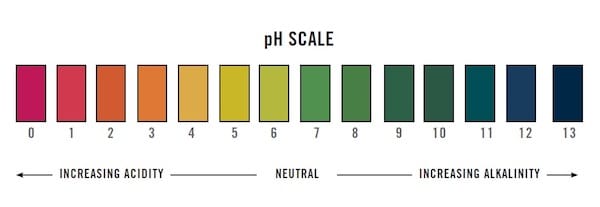
Why is it so important?
Well if it is too far out of balance it can affect the effectiveness of the chlorine or bromine sanitisers.
It will cause skin or eye irritation. And what it can do to your hair, well that would need a whole article on its own. So lets not go there.
It will also shorten filter life, and potentially shorten the life of the heater/pump combo unit. So all in all it’s pretty important.
What range are we looking for?
We’re looking for our water to be in the range of 7.2 to 7.8 pH. If we find our tub outside that range, there are many products the will increase or decrease the value to within the optimum parameters.
SANITISERS
Bacteria love warm water. So we need to discourage them from loving our warm water. Thats where sanitisers come in.
There are many approaches to sanitising our hot tub. The two most commonly used are the addition of chlorine or bromine.
Because these chemicals are dispersed in the tub water we have to measure the concentration of them. There are test kits for this, or even easier test strips are available for checking the PPM of the chemical dispersed in the spa.
PPM is short for Parts Per Million. We would generally be looking for around 2 – 3 PPM for chlorine, and a little higher for bromine at around 3 – 5.0 PPM. Tiny amounts you’ll agree but without them we have hot tub hell!! Lets see how to maintain a clear and sparkling hot tub.
CHLORINE
Everyone is familiar with chlorine. It is a widely used chemical in pools and hot tubs. So how does it sanitise our hot tub?
If we add chlorine to perfectly pure and clean water in our hot tub, it simply disperses to become what is called free chlorine. As the water becomes contaminated by use, the free chlorine attaches to the contaminants and becomes combined chlorine (or chloramines).
It’s chloramines that produce the chlorine odour that many people find unpleasant. When we complain of too much chlorine, it is normally the chloramines causing the powerful chlorine smell.
One of the downsides when adding chlorine to your hot tub is that it does have a short effective life in hot water. So requires constant monitoring, adjusting and adding. The upside is that it is cheap.
BROMINE
Bromine and chlorine are very closely related in what they are able to achieve for us in our hot tub. But bromine acts a little differently than chlorine. It is much more stable in hot water, and so is able to maintain it’s residual content in the hot water better.
When the bromine content has finished its effective sanitising cycle it remains dormant in the tub. By adding a non-chlorine shock treatment the bromine springs back into life and start sanitising your tub again.
Bromine is generally more expensive than chlorine, but requires less attention and less quantity to keep the tub pristine. It also does not have the unpleasant chlorine odour.
SPA SHOCK
Spa shock is used to destroy organic contaminants that have been able to escape normal sanitation methods.
There are some other compelling reasons to shock your hot tub. Chemical treatment using spa shock depend on the type of sanitiser being used, so be careful to add the right one to get the best results. The shock treatment should be specific to either bromine or chlorine treated hot tubs not both.For bromine treated spas we recommend using a chlorine free shock treatment.
They are normally quick dissolving which is useful when treating the tub in the summer months when it is generally getting the most use. This type of treatment does not use test strips for testing, so it is very important to follow the manufacturers instructions carefully.
Chlorine treated tubs are generally treated with granules that are shaken into the tub so keep the pump running on a high setting to quickly disperse them
Interesting All In One Starter Kits
No products found.
Interesting Articles
Images from Amazon Product Advertising
